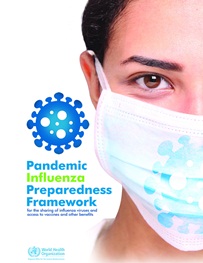Pandemic Influenza Preparedness Framework

Pandemic influenza preparedness
Influenza is a highly infectious viral illness that infects both humans and animals.
Pandemic influenza occurs when people are affected by a new influenza virus against which they have no immunity. It spreads through sustained human-to-human transmission. Given the limited immunity in a population, a pandemic influenza virus may spread to all parts of the world. Past pandemics have been caused by viruses that typically originated from animal influenza viruses.
During the outbreaks of H5N1 influenza in 2006, it became clear to WHO Member States that a formal arrangement was needed to increase access to vaccines during influenza pandemics, particularly for countries in need. At the same time, Member States recognized that ongoing, systematic virus-sharing was critical to ensure continuous global monitoring, risk assessment and aid in order to develop safe and effective pandemic influenza vaccines.
In 2007, WHO Member States came together to start negotiating and interacting with industry, civil society organizations, and other stakeholders over the next 4 years to draft the Pandemic Influenza Preparedness (PIP) Framework.
In doing so, WHO facilitated a landmark step forward in public health, when the PIP Framework was unanimously adopted by the 194 countries of the World Health Assembly on 24 May 2011. The PIP Framework is thus a global effort to improve preparedness and response for the next influenza pandemic.
Implementation of the Framework in the Eastern Mediterranean Region has been underway since July 2014 and countries have shown great progress in developing infrastructure and building systems that address sustainable influenza surveillance and pandemic preparedness.
As of October 2016, over 17 countries in the Region have a functioning influenza-like illness and severe acute respiratory infections surveillance system, while 16 designated national influenza centres are operational with the ability to detect and confirm unusual influenza viruses with human pandemic potential.








